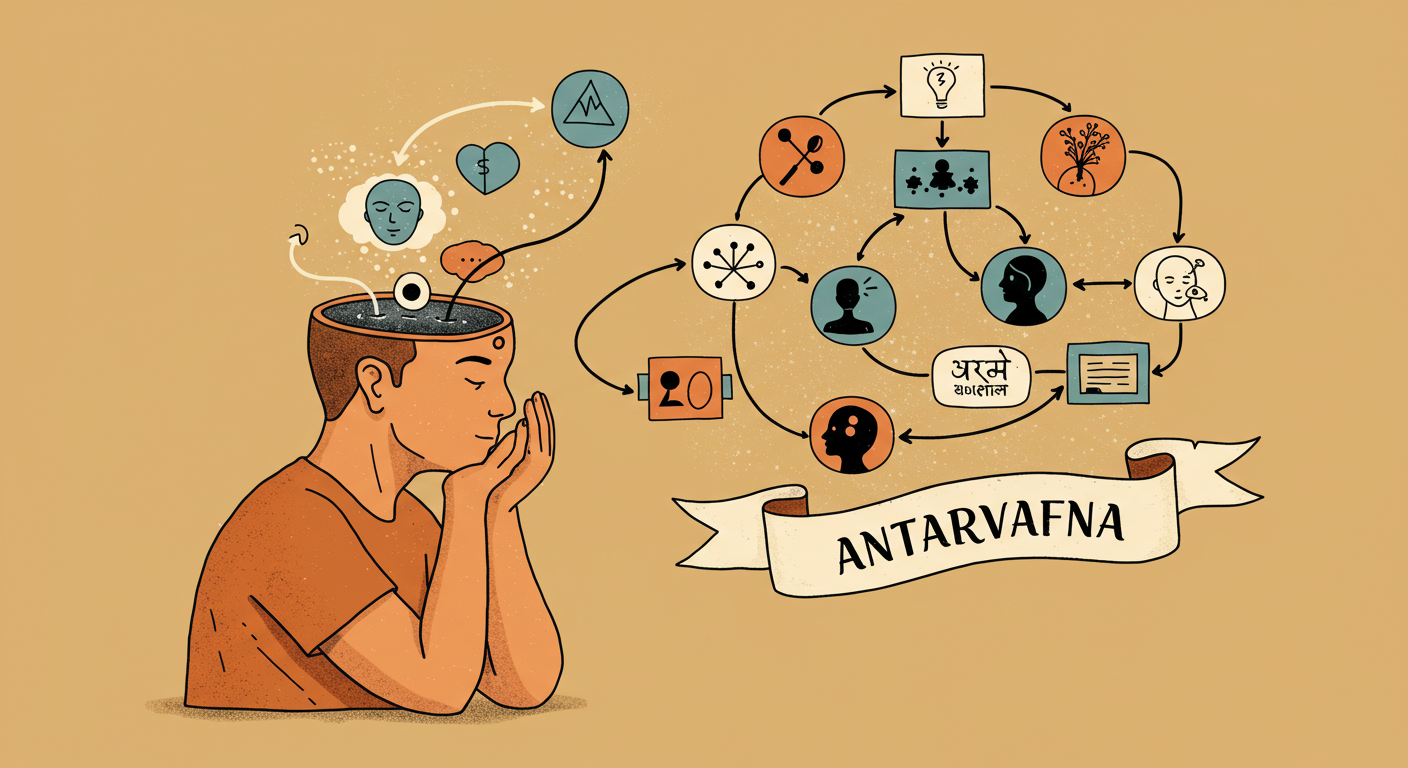Imagine standing at a crossroads – a career change, a relationship dilemma, a moment of overwhelming stress. Amidst the noise of advice, societal pressure, and your own swirling thoughts, a quiet yet distinct voice whispers from within. That is the essence of Antarvafna. More than just thinking, it’s the profound art of conscious, compassionate inner dialogue. It’s not ancient mysticism reserved for gurus; it’s a practical, deeply human skill waiting to be rediscovered in your daily life. Let’s explore how tuning into this inner conversation can transform your world.
What Is Antarvafna? Beyond the Buzzword
-
Defining the Concept of Inner Conversation: At its core, Antarvafna (derived from Sanskrit roots suggesting “inner” and “voice” or “sound”) is the practice of intentionally engaging in a two-way dialogue with yourself. It’s not passive rumination or anxious overthinking. Think of it as sitting down with your wisest, kindest friend – who happens to be you – to explore your feelings, thoughts, motivations, and truths. It’s asking yourself genuine questions and truly listening to the answers that arise from your intuition and deeper understanding.
-
Why Antarvafna Matters in Daily Life (Right Now!): In our hyper-connected, externally focused world, we’re constantly bombarded. We scroll, we react, we perform. Antarvafna is the counterbalance. It’s the pause button. It matters because it reconnects you to your authentic self. When Priya felt burnt out but kept pushing, Antarvafna wasn’t about grand enlightenment; it was her inner voice gently saying, “You need rest. It’s okay to slow down.” Ignoring it led to illness; listening brought healing. It’s the compass that helps you navigate life’s messy, real moments.
The Transformative Benefits of Practicing Antarvafna
This isn’t just feel-good philosophy; cultivating inner dialogue delivers tangible rewards:
-
Enhancing Self-Awareness (Knowing Your True North): Regular Antarvafna is like shining a light into your inner landscape. You start recognizing your patterns: Why does that colleague’s comment always trigger me? What truly brings me joy, not just distraction? Like Ravi, who realized through inner dialogue that his pursuit of a high-paying finance job stemmed from family expectation, not personal passion, leading him courageously towards teaching.
-
Boosting Emotional Intelligence (Your Inner EQ Coach): By acknowledging and exploring your feelings internally (“I feel hurt… why? What does this need tell me?”), you become better at understanding and managing emotions – yours and others’. You respond instead of react. Sudha found that after a tense meeting, her Antarvafna practice helped her identify her own defensiveness before snapping at her team, allowing for a calmer, more constructive approach later.
-
Improving Decision-Making Skills (Clarity Over Confusion): Big decisions become less paralyzing. Antarvafna helps you weigh options with your intuition and values, not just logic or external pressure. Ask: “What does my gut say? What aligns with my core values? What am I truly afraid of here?” For Arjun, facing a lucrative job offer in a toxic environment, his inner dialogue revealed his deep need for respect and peace over prestige, guiding his clear “no.”
How to Cultivate Antarvafna: Your Personal Toolkit
Ready to start your inner conversation? Here’s your accessible guide:
-
Create a Quiet Space for Reflection (It’s Simpler Than You Think): You don’t need a Himalayan cave. Find 5-10 minutes. It could be early morning before the house stirs, during your lunch break in a park, or even just sitting in your parked car. Turn off notifications. The goal isn’t total silence (life happens!), but intentional separation from the external chatter. Even closing your eyes for a minute at your desk counts.
-
Ask Meaningful Questions (The Key to Unlocking Insight): Ditch vague thoughts like “What should I do?”. Be specific and kind:
-
“What am I truly feeling right now, beneath the surface?”
-
“What do I need most in this situation?”
-
“Is this [action/thought] aligned with who I want to be?”
-
“What’s the kindest thing I can say to myself about this?” Start with one question per session.
-
-
Listen to Your Inner Voice (Patience is the Practice): This is the heart of Antarvafna. After asking, pause. Breathe. Listen. The answer might come as:
-
A sudden feeling of ease or tightness in your body.
-
A clear word or phrase popping into your mind.
-
A fleeting image or memory.
-
A simple sense of “knowing.” Don’t force it. Trust that the response will emerge in its own way and time. It might feel faint at first – like tuning into a distant radio station. Be patient.
-
Navigating Common Challenges on the Antarvafna Path
Like any new skill, hurdles arise. Here’s how to meet them:
-
Overcoming Mental Distractions (The Monkey Mind): Your brain will wander. That’s normal! Gently acknowledge the thought (“Oh, there’s my grocery list”) and return your focus to your breath or your chosen question. No judgment. It’s a muscle you strengthen.
-
Dealing with Negative Self-Talk (The Inner Critic): Sometimes the loudest “voice” is harsh criticism. When this happens, consciously shift the dialogue. Ask: “Would I speak this way to my best friend?” Then, consciously offer yourself the compassion you’d give them. Counter the critic with: “I’m doing my best,” or “This is hard, but I’m learning.”
-
Finding Time for Inner Dialogue (Busy Lives, Busy Minds): Start microscopically. Aim for 2 minutes, not 20. Integrate it into existing routines: shower thoughts, washing dishes, walking. The quality of presence matters more than the duration. Consistency trumps perfection.
Antarvafna and Your Mental Well-Being: A Powerful Ally
This practice is deeply intertwined with emotional health:
-
Reducing Stress Through Self-Reflection: By identifying the true sources of your stress (often hidden fears or unmet needs) via inner dialogue, you can address them more effectively. Simply naming your feelings (“I feel overwhelmed because I’m taking on too much”) reduces their intensity and creates space for solutions.
-
Building Resilience with Inner Conversations: Life throws curveballs. Antarvafna helps you process setbacks internally. Instead of spiraling, you can ask: “What can I learn from this? What strengths do I have to handle it? What support do I need?” This builds an inner foundation of strength and adaptability.
Practical Tips to Weave Antarvafna into Your Days
Make it stick with these habits:
-
Journaling for Deeper Insights: Write down your questions and the responses that arise. Don’t censor! Seeing your inner dialogue on paper provides clarity and reveals patterns over time. Try stream-of-consciousness writing for 5 minutes.
-
Meditation Techniques for Inner Clarity: While distinct (see below), mindfulness meditation cultivates the focused attention needed for Antarvafna. Try a short breath-awareness meditation to calm the mind before starting your inner dialogue.
-
Setting Intentions for Meaningful Dialogue: Begin your day by asking: “What quality do I want to cultivate today? (e.g., patience, courage)” or “What do I need to be mindful of?” Check in briefly throughout the day.
How Antarvafna Differs from (and Complements) Meditation
-
Key Similarities Between the Two Practices: Both cultivate inner awareness, require focused attention, and promote calm. Both encourage non-judgmental observation of thoughts and feelings. Meditation often provides the foundation of focus that makes Antarvafna more accessible.
-
Unique Aspects of Antarvafna: Meditation often aims for stillness, observation, or emptiness. Antarvafna is inherently dialogical and active. It’s about engaging – asking specific questions, seeking insight, and fostering an interactive relationship with your inner self. It’s more conversational and directed towards practical understanding and problem-solving.
Real-Life Antarvafna: It’s Happening All Around You
-
How Successful People Use Inner Dialogue (Quietly): Think of the leader pausing thoughtfully before answering a tough question – they’re likely consulting their inner wisdom. The artist stepping back from a piece, asking internally, “Does this feel true?” The entrepreneur weighing a risk, tuning into both data and their gut feeling. Success often involves deep self-trust honed through inner dialogue.
-
Everyday Scenarios for Practicing Antarvafna:
-
Before reacting angrily to a message: “What am I really upset about?”
-
Facing a difficult conversation: “What’s my true intention here? What do I need to express?”
-
Feeling overwhelmed: “What’s the one small thing I can do right now?”
-
Making a choice: “Which option brings me more peace/alignment?”
-
After a mistake: “What can I learn? How can I be kind to myself right now?”
-
Conclusion: Embrace Antarvafna – Your Journey Inward Begins Now
Antarvafna isn’t about achieving perfection or some esoteric state. It’s about reclaiming a fundamental human capacity: the deep, compassionate conversation with yourself. It’s about navigating life not just from the neck up, but from the heart and gut outward. In a world shouting for your attention, Antarvafna is the quiet sanctuary within, offering clarity, resilience, and a profound connection to your authentic self. Start small. Ask one honest question today. Listen patiently. Your inner voice, your wisest guide, has been waiting to speak. Embrace the dialogue, and watch your personal growth unfold.
Frequently Asked Questions (FAQs)
-
What Does Antarvafna Mean?
Antarvafna originates from Sanskrit, combining “antar” (inner, within) and “vāṇī” or “vāc” (voice, sound, speech). It essentially translates to “inner voice” or “inner dialogue,” representing the conscious practice of engaging in a meaningful conversation with oneself. -
How Can Beginners Start Practicing Antarvafna?
Start incredibly small! Commit to just 2-5 minutes daily. Find a relatively quiet moment (morning coffee, evening wind-down). Ask yourself one simple, kind question: “How am I really feeling right now?” or “What do I need most today?” Then, simply listen without judgment. Notice any sensations, thoughts, or feelings that arise. Don’t force answers; focus on the act of asking and listening. Journaling the question and anything that comes up can be helpful. -
Is Antarvafna the Same as Mindfulness?
They are closely related but distinct. Mindfulness is the practice of paying non-judgmental attention to the present moment (thoughts, feelings, sensations, surroundings). Antarvafna uses mindful awareness but goes a step further. It’s specifically about initiating and engaging in an active, internal dialogue – asking yourself questions and listening for insights, understanding, and guidance from within. Mindfulness is the foundation; Antarvafna is the conversation built upon it. -
How Often Should You Practice Antarvafna?
Consistency is more important than duration. Aim for short sessions (5-10 minutes) most days. Even practicing 3-4 times a week yields benefits. The key is to integrate the spirit of it into your daily life – pausing briefly before reacting, checking in with yourself during moments of stress, asking “what’s true for me?” when making choices. -
Can Antarvafna Improve Relationships?
Absolutely, and profoundly. By understanding your own needs, triggers, and emotional patterns through inner dialogue, you become less reactive and more empathetic. You communicate more clearly because you understand your own position better. You can approach conflicts with greater self-awareness and compassion. Understanding yourself deeply is the first step towards understanding and connecting authentically with others.

